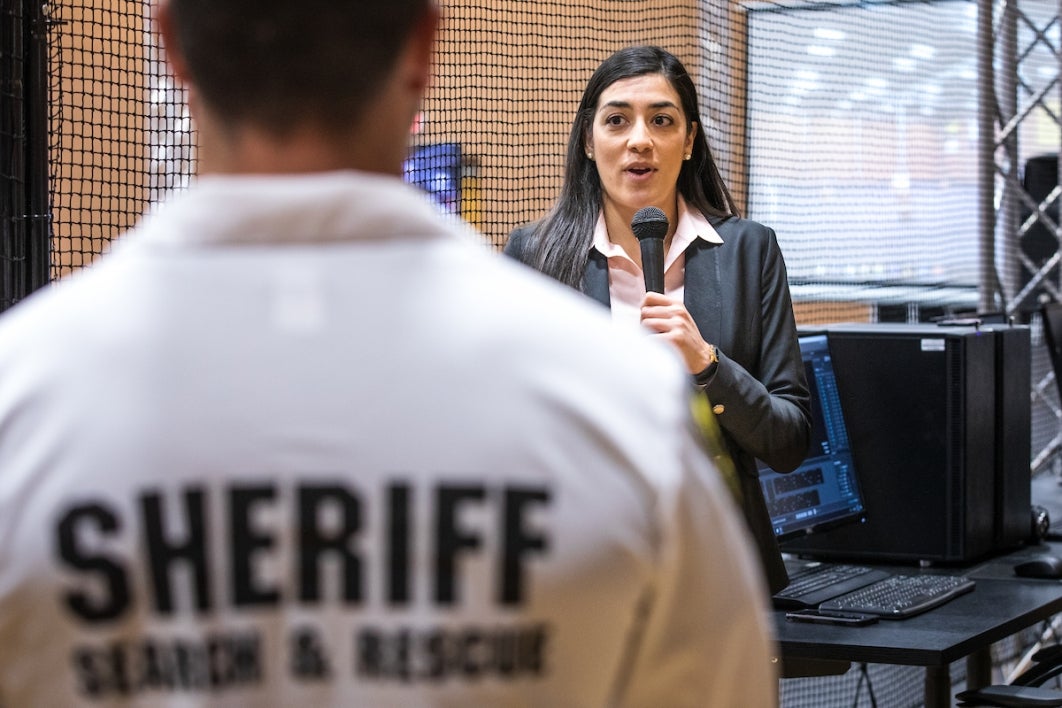ASU, Arizona partner to develop autonomous, unmanned systems for rescue operations

A new partnership to advance drone technology designed specifically for search and rescue (SAR) missions has been developed between Arizona State University, the Arizona Department of Emergency and Military Affairs (DEMA), and the Arizona Search and Rescue Coordinators Association (ASARCA).
According to ASU Assistant Professor Stephanie Gil, a computer science engineer who specializes in multi-robot and communication systems, the ASU team will rely on the expertise of the DEMA search and rescue experts to guide the development of systems that can support teams in the field — whether that field is actually a mountainous cavern or a dense city center.
“We will develop the intelligence, or the software, that will run on the robots so they can gather environmental information and then use it to perform actions as a team,” Gil said.
In addition to mapping the search environment and establishing a communication infrastructure between the robots and the DEMA team, the robots will be resilient to hacking.
Other possible applications for the unmanned, autonomous systems include the ability to perform emergency equipment repairs for underwater or underground pipelines, or to track adversarial agents in a populated area.
Funding for the collaboration is possible through Gil’s National Science Foundation Early Career Development Program (CAREER) Award, which centers on cyberphysical systems and coordinated swarm behaviors.
“In addition to advancing the technology for these systems, the collaboration provides an opportunity for ASU students to work on real-world scenarios with experts in the field,” Gil explained. “This prepares them to go into the workforce with direct experience analyzing challenges, designing solutions, and then seeing those solutions have a direct impact in the community.”
Assistant Professor Stephanie Gil introduces a drone simulation to statewide search and rescue officers during an Arizona Search and Rescue Coordinators Association (ASARCA) meeting hosted by ASU Engineering. Photo by Charlie Leight/ASU Now
Jeremy Ramirez, a Pima County deputy and search and rescue coordinator, who is also the outgoing president of ASARCA, noted that the forthcoming technology will be valuable for many types of search and rescue operations.
“We recently performed an Alzheimer’s walkaway search,” said Ramirez about a scenario where a person with Alzheimer’s wandered away from a caregiver. “Being able to do a fast, coordinated drone search where we get feedback immediately instead of waiting until volunteers return from walking the grid will greatly improve our rescue operations.”
While Pima County is just beginning to use autonomous systems for search and rescue operations, Coconino County in northern Arizona has developed a more robust program.
“There are many treacherous areas where I don’t want to send a sheriff department search team, let alone volunteers,” explained Paul Clifton, a Coconino County sheriff’s deputy and search and rescue coordinator.
Clifton also pointed out that even though volunteer ground searchers may think they have covered the grid, “GPS tells us that there are actually many areas that aren’t covered. Using a drone swarm will help us ensure that we’ve covered as much ground as possible in a search and rescue operation where the ability to cover a wide area is a factor,” he said.
Creating a statewide program for deploying autonomous systems technology for search and rescue operations is a goal for Jesse Robinson, Arizona’s statewide DEMA coordinator. Robinson supports search and rescue operations for about 600 missions annually in Arizona, providing resources and training to 15 sheriff’s offices.
“As far as I know, no other states are at the point of developing a cooperative program across all counties,” Robinson said. “Some counties in Arizona are more experienced at (autonomous systems) operations, while some of the smaller counties, like Greenlee, have no experience or resources at all.
“Our hope is that this partnership will enhance our search and rescue operations no matter how remote or treacherous an area may be.”
Arizona’s advantage for a statewide collaboration is further enhanced by ASU’s Drone Studio, a 10,000-square-foot facility with 23-foot ceilings and 105 cameras that can track high speed motion dynamics with 360 measurements per second. According to Gil, the system can track 150 flying and ground vehicles at the same time.
“It’s the perfect place to launch the SAR initiative,” Gil said. “We have safety in a controlled environment that meets FAA regulations. We can add disturbances like wind and light, and we have the systems to develop analytics for the kind of human-swarm interactions and tactics that will be necessary for AUS SARautonomous systems search and rescue missions.”
Top photo: Assistant Professor Stephanie Gil (left) along with computer science doctoral students Weiying Wang and Ninad Jadhav (right) talk with DEMA official Jesse Robinson in the ASU Drone Studio on the Tempe campus during a meeting of the Arizona Search and Rescue Coordinators Association. Gil, a computer science engineer, directs the REACT Lab (Robotics, Embedded Autonomy, and Communication Theory Lab). Robinson is the search andrescue and warning coordinator for the agency. The Arizona Search and Rescue Coordinators Association held its quarterly meeting at ASU on Jan. 15 to enable search and rescue departments from around the state to collaborate with engineering students on drone and remote-controlled technological developments. Photo by Charlie Leight/ASU Now
More Science and technology

Will this antibiotic work? ASU scientists develop rapid bacterial tests
Bacteria multiply at an astonishing rate, sometimes doubling in number in under four minutes. Imagine a doctor faced with a patient showing severe signs of infection. As they sift through test…

ASU researcher part of team discovering ways to fight drug-resistant bacteria
A new study published in the Science Advances journal featuring Arizona State University researchers has found vulnerabilities in certain strains of bacteria that are antibiotic resistant, just…

ASU student researchers get early, hands-on experience in engineering research
Using computer science to aid endangered species reintroduction, enhance software engineering education and improve semiconductor material performance are just some of the ways Arizona State…
